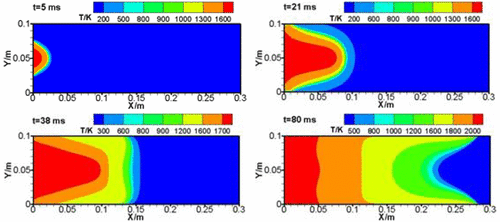当前位置:
X-MOL 学术
›
Energy Fuels
›
论文详情
Our official English website, www.x-mol.net, welcomes your feedback! (Note: you will need to create a separate account there.)
Numerical Study on Premixed Methane–Air Flame Propagation in a Confined Vessel at Low Initial Temperature
Energy & Fuels ( IF 5.3 ) Pub Date : 2018-01-11 00:00:00 , DOI: 10.1021/acs.energyfuels.7b03433 Gan Cui 1, 2, 3 , Zili Li 1, 2, 3 , Hongbo Li 1, 2, 3 , Zhenxiao Bi 1, 2, 3 , Shun Wang 1, 2, 3
Energy & Fuels ( IF 5.3 ) Pub Date : 2018-01-11 00:00:00 , DOI: 10.1021/acs.energyfuels.7b03433 Gan Cui 1, 2, 3 , Zili Li 1, 2, 3 , Hongbo Li 1, 2, 3 , Zhenxiao Bi 1, 2, 3 , Shun Wang 1, 2, 3
Affiliation

|
In this article, premixed methane–air flame propagation in a confined vessel at low initial temperature was simulated using a multistep chemical reaction mechanism. The confined vessel was a cylinder with aspect ratio of 3 with asymmetrical position of the ignition source near the side cover. The equivalence ratio and the initial temperature of the premixed unburned combustible gas were 1.0 and 150 K, respectively. The overall evolution of the flame and the flame dynamics were obtained, respectively. Through the entire flow field variation, vortex movement, and pressure wave propagation characteristics during the whole process of combustion, the flame propagation mechanism of methane combustion at low initial temperature was established finally. Results indicate that five stages are divided during the methane combustion in a confined vessel: spherical flame propagation, “fingertip” shaped flame propagation, flame “skirt edge” contacts the side wall, “crescent” flame propagation, and typical “tulip” flame propagation. In the process of flame propagation, the reverse of the flame front and formation of the “tulip” flame can be immediately contributed to the interaction of the flame front, flame induced reverse flow, and vortex motion. However, the pressure wave propagation back and forth along the flame propagation direction has no obvious effect on the formation of tulip flame. When the distorted tulip flame is formed, vortex motion is not observed. The formation of the distorted tulip flame is caused by the superposition of the secondary pressure wave formed by the contact of the flame with side wall. However, because of the low intensity of pressure wave, RT instability is weak, and the distortion of flame front is not obvious. Flame propagation velocity and pressure wave are interacted with each other. In the process of combustion, the variation of flame propagation velocity and pressure rise rate show almost the same phase. The increase in flame propagation velocity directly leads to the increase in pressure rise rate, whereas the pressure wave propagation back and forth in the confined vessel leads to the oscillation of propagation velocity.
中文翻译:

低初始温度下密闭容器中甲烷-空气预混火焰传播的数值研究
在本文中,使用多步化学反应机理模拟了甲烷-空气火焰在低初始温度下在密闭容器中的传播。密闭容器是长径比为3的圆柱体,点火源在侧盖附近位置不对称。预混合的未燃烧可燃气体的当量比和初始温度分别为1.0 K和150K。分别获得了火焰的整体演变和火焰动力学。通过在整个燃烧过程中的整个流场变化,涡旋运动和压力波传播特性,最终建立了低初始温度下甲烷燃烧的火焰传播机理。结果表明,密闭容器中的甲烷燃烧过程分为五个阶段:球形火焰传播,“指尖”形火焰传播,火焰“裙边”与侧壁接触,“新月形”火焰传播以及典型的“郁金香”形火焰传播。在火焰传播的过程中,火焰前沿的反向和“郁金香”火焰的形成可以立即促进火焰前沿,火焰诱导的逆流和涡旋运动的相互作用。但是,沿火焰传播方向来回传播的压力波对郁金香火焰的形成没有明显的影响。当形成扭曲的郁金香火焰时,没有观察到涡旋运动。变形的郁金香火焰的形成是由于火焰与侧壁接触而形成的二次压力波的叠加引起的。但是,由于压力波强度低,RT不稳定性很弱,火焰锋变形不明显。火焰传播速度和压力波相互影响。在燃烧过程中,火焰传播速度和压力上升率的变化呈现出几乎相同的相位。火焰传播速度的增加直接导致压力上升速率的增加,而压力波在密闭容器中来回传播会导致传播速度的振荡。
更新日期:2018-01-11
中文翻译:

低初始温度下密闭容器中甲烷-空气预混火焰传播的数值研究
在本文中,使用多步化学反应机理模拟了甲烷-空气火焰在低初始温度下在密闭容器中的传播。密闭容器是长径比为3的圆柱体,点火源在侧盖附近位置不对称。预混合的未燃烧可燃气体的当量比和初始温度分别为1.0 K和150K。分别获得了火焰的整体演变和火焰动力学。通过在整个燃烧过程中的整个流场变化,涡旋运动和压力波传播特性,最终建立了低初始温度下甲烷燃烧的火焰传播机理。结果表明,密闭容器中的甲烷燃烧过程分为五个阶段:球形火焰传播,“指尖”形火焰传播,火焰“裙边”与侧壁接触,“新月形”火焰传播以及典型的“郁金香”形火焰传播。在火焰传播的过程中,火焰前沿的反向和“郁金香”火焰的形成可以立即促进火焰前沿,火焰诱导的逆流和涡旋运动的相互作用。但是,沿火焰传播方向来回传播的压力波对郁金香火焰的形成没有明显的影响。当形成扭曲的郁金香火焰时,没有观察到涡旋运动。变形的郁金香火焰的形成是由于火焰与侧壁接触而形成的二次压力波的叠加引起的。但是,由于压力波强度低,RT不稳定性很弱,火焰锋变形不明显。火焰传播速度和压力波相互影响。在燃烧过程中,火焰传播速度和压力上升率的变化呈现出几乎相同的相位。火焰传播速度的增加直接导致压力上升速率的增加,而压力波在密闭容器中来回传播会导致传播速度的振荡。



























 京公网安备 11010802027423号
京公网安备 11010802027423号